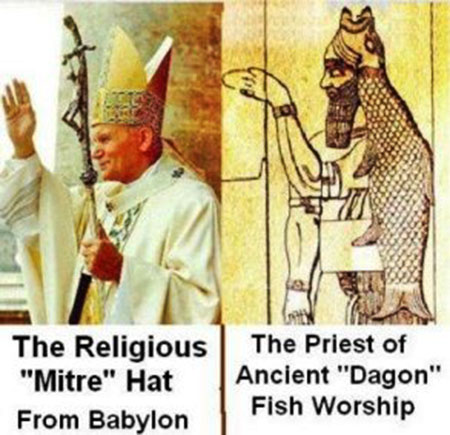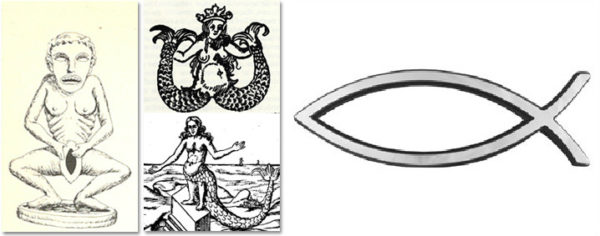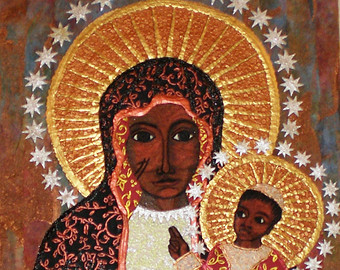Doobie Doo
Veteran
33
24
Google +
2
Reddit
6
13
1
Next »
Pages: 1 2 3 4 5
ADVERTISEMENT

Cross Was Originally a Pagan Symbol
The cross is regarded as one of the core symbols of Christianity. It is believed to be a holy symbol originating from the Christian religion as a symbol that represents God’s sacrifice of Jesus Christ at Calvary. The truth is, however, the cross is actually a pagan symbol that wasn’t even considered a Christian symbol for years after Yeshua the Messiah was born. Sandy Nagy, an Examiner contributor and author who focuses on numerous biblical subjects, wants people to consider a few things before assuming the cross is a symbol of Christian origin.
“If the cross is a Christian symbol, then why is it traceable way back to Babylon and Egypt, as far back as 2,000 B.C. … ?” Nagy wrote in an article for the Examiner. “Many ancient cultures used crosses or the mystic Tau. Babylon seems to be the originator from ancient Chaldea, but you can find crosses in Egypt, India, China, Africa, Mexico, Greece, Italy, and South American histories. All before Yeshua was ever born.”

St. Peter’s Square’s Connection to Ishtar
Roger Turner, the author of “Trinity Matrix 2008,” noted that the Babylonian goddess of Ishtar was often symbolized by an eight-point star, or “sun wheel,” a symbol scholars believe inspired the design of St. Peter’s Square. An aerial view of the plaza at the Vatican reveals eight “spokes” that emerge from the wheel’s center — a genuine Egyptian obelisk. Its physical resemblance to the Egyptian imagery is apparent and the use of an authentic Egyptian obelisk makes the connection hard to ignore.

ADVERTISEMENT
The Pope’s Mitre Is First Depicted in Images of a Babylonian Fish-God
For those who have ever looked at the tall mitre worn by the pope and thought it resembled a fish, there is actually a historical reason for that. This headdress originated from a similar garment depicted in images of Dagon, the fish-god of the Philistines and Babylonians. In Ruben Joseph’s book titled “Why Are the Young People Leaving the Church,” he details the hat’s origins. “The mitre is derived directly from the mitres of the ancient pagan fish-god Dagon and the goddess Cybele,” Joseph writes. “The papal mitre represents the head of Dagon with an open mouth, which is the reason for the pointed shape and split top.”

The Six-Sided Star on the Pope’s Mitre Is a Symbol of Satanic Tyranny
It doesn’t get more painfully ironic than realizing the most prominent figure of the Roman Catholic Church dons satanic symbolism on a daily basis. The six-sided star on the pope’s mitre, which is composed of six triangles, six points and a six-sided hexagon (6,6,6), is widely regarded as the emblem of the Theosophical Society. This society was founded by Helena Blavatsky who infamously proclaimed and insisted that “Lucifer is the true God.”

ADVERTISEMENT
At the Center of St. Peter’s Basilica Lies Yet Another Connection to Ishtar
At the center of St. Peter’s Basilica, another symbolic nod to Ishtar, who has been represented by an eight-pointed star for centuries, can be found. A ring of eight eight-pointed stars surrounds the very spot inside St. Peter’s Basilica where the pope sits.

Dove Used to Depict Ishtar and other Goddesses
Many believe that the dove is just another beautiful bird without the context of the Bible, where it served as a symbol of hope and peace. The dove’s presence as a religious symbol actually extends beyond delivering an olive branch to Noah, however. The “Masks of God: Occidental Mythology,” noted back in 1976 that the dove was deemed the “symbolic animal” of Ishtar, the Babylonian goddess of war, death and love. The bird also was used to symbolize other goddesses including Inanna, Astarte, Atargatis and Aphrodite.

Jesus Likely Looked Nothing Like the Paintings We See Today
Paintings of Jesus have long portrayed him as petite in his build with long, flowing tresses and pale skin. It’s a description that many scholars adamantly argue against. It isn’t likely that Jesus would have been frail and petite in build because the Bible states he was a carpenter — something that would have given him a much more athletic build. As for his hair, 1 Corinthians 11:14 notes that during this time it was a shame for any man to have long hair. Combined with his occupation as a carpenter, scholars doubt the accuracy of a long-haired Jesus. Then there is the idea that he was a handsome man with a coveted bone structure, but the only time the Bible even references his appearance it is to note the fact that Jesus was likely the exact opposite. In Isaiah, he is described as having “no form of majesty that we should look at him, and no beauty that we should desire him.”

Jesus Wasn’t White
There is a plethora of academic studies that argue what race Jesus was, but none have seemed to reach a general consensus. What has been widely agreed on, however, is that the biblical figure would not have been the pale-skinned man depicted in art and literature today. English writer Godfrey Higgins suggested back in 1863 that Jesus would have been a dark-skinned Indo-Aryan from North India. Mark Goodacre, a senior lecturer at the Department of Theology and Religion at the University of Birmingham, used several academic sources to create a CGI image of what Jesus would have probably looked like. The image unveiled a man of a much darker skin complexion. As The Atlantic notes, “The scholarly consensus is actually that Jesus was, like most first-century Jews, probably a dark-skinned man. If he were taking the red-eye flight from San Francisco to New York today, Jesus might be profiled for additional security screening by TSA.”

The Jesus Fish Is Actually a Vagina
As awkward as it may seem, that popular fish that is branded on many car bumpers and wristbands is actually a representation of a vagina. The symbol is known as the ichthys, but the symbol actually dates back to a time when “Christianity was still an obscure sect,” Cracked’s Cezary Jan Strusiewicz explains. Even Christian scholars have started to note the symbol’s origins. A Cracked article that cites research from two Christian-based organizations explains that the ichthys “was used as a symbol of every female fertility god ever” including Atargatis, the Syrian fertility goddess, and the Great Mother goddess, “where it symbolized her life-giving vulva.”

Symbolism of the Black Madonna
Black Madonna is a term used to refer to any statue or painting of Mary that depicts her with a darker skin complexion than more traditional, Western art portraits. There are many theories behind why the string of “Black Mary” images were created. An article published by the University of Dayton gives some of these reasons — an attempt to depict Mary with the skin complexion “of the indigenous population,” the mere deterioration of lead-based pigments or an attempt to “illustrate a text from the Song of Songs: ‘I am black but beautiful.’” Either way, the Black images of Mary have been conveniently ignored by many Christian leaders.
http://atlantablackstar.com/2015/03...y-that-your-pastor-probably-never-told-you/5/
24
Google +
2
6
13
1
Next »
Pages: 1 2 3 4 5
ADVERTISEMENT

Cross Was Originally a Pagan Symbol
The cross is regarded as one of the core symbols of Christianity. It is believed to be a holy symbol originating from the Christian religion as a symbol that represents God’s sacrifice of Jesus Christ at Calvary. The truth is, however, the cross is actually a pagan symbol that wasn’t even considered a Christian symbol for years after Yeshua the Messiah was born. Sandy Nagy, an Examiner contributor and author who focuses on numerous biblical subjects, wants people to consider a few things before assuming the cross is a symbol of Christian origin.
“If the cross is a Christian symbol, then why is it traceable way back to Babylon and Egypt, as far back as 2,000 B.C. … ?” Nagy wrote in an article for the Examiner. “Many ancient cultures used crosses or the mystic Tau. Babylon seems to be the originator from ancient Chaldea, but you can find crosses in Egypt, India, China, Africa, Mexico, Greece, Italy, and South American histories. All before Yeshua was ever born.”

St. Peter’s Square’s Connection to Ishtar
Roger Turner, the author of “Trinity Matrix 2008,” noted that the Babylonian goddess of Ishtar was often symbolized by an eight-point star, or “sun wheel,” a symbol scholars believe inspired the design of St. Peter’s Square. An aerial view of the plaza at the Vatican reveals eight “spokes” that emerge from the wheel’s center — a genuine Egyptian obelisk. Its physical resemblance to the Egyptian imagery is apparent and the use of an authentic Egyptian obelisk makes the connection hard to ignore.

ADVERTISEMENT
The Pope’s Mitre Is First Depicted in Images of a Babylonian Fish-God
For those who have ever looked at the tall mitre worn by the pope and thought it resembled a fish, there is actually a historical reason for that. This headdress originated from a similar garment depicted in images of Dagon, the fish-god of the Philistines and Babylonians. In Ruben Joseph’s book titled “Why Are the Young People Leaving the Church,” he details the hat’s origins. “The mitre is derived directly from the mitres of the ancient pagan fish-god Dagon and the goddess Cybele,” Joseph writes. “The papal mitre represents the head of Dagon with an open mouth, which is the reason for the pointed shape and split top.”

The Six-Sided Star on the Pope’s Mitre Is a Symbol of Satanic Tyranny
It doesn’t get more painfully ironic than realizing the most prominent figure of the Roman Catholic Church dons satanic symbolism on a daily basis. The six-sided star on the pope’s mitre, which is composed of six triangles, six points and a six-sided hexagon (6,6,6), is widely regarded as the emblem of the Theosophical Society. This society was founded by Helena Blavatsky who infamously proclaimed and insisted that “Lucifer is the true God.”

ADVERTISEMENT
At the Center of St. Peter’s Basilica Lies Yet Another Connection to Ishtar
At the center of St. Peter’s Basilica, another symbolic nod to Ishtar, who has been represented by an eight-pointed star for centuries, can be found. A ring of eight eight-pointed stars surrounds the very spot inside St. Peter’s Basilica where the pope sits.

Dove Used to Depict Ishtar and other Goddesses
Many believe that the dove is just another beautiful bird without the context of the Bible, where it served as a symbol of hope and peace. The dove’s presence as a religious symbol actually extends beyond delivering an olive branch to Noah, however. The “Masks of God: Occidental Mythology,” noted back in 1976 that the dove was deemed the “symbolic animal” of Ishtar, the Babylonian goddess of war, death and love. The bird also was used to symbolize other goddesses including Inanna, Astarte, Atargatis and Aphrodite.

Jesus Likely Looked Nothing Like the Paintings We See Today
Paintings of Jesus have long portrayed him as petite in his build with long, flowing tresses and pale skin. It’s a description that many scholars adamantly argue against. It isn’t likely that Jesus would have been frail and petite in build because the Bible states he was a carpenter — something that would have given him a much more athletic build. As for his hair, 1 Corinthians 11:14 notes that during this time it was a shame for any man to have long hair. Combined with his occupation as a carpenter, scholars doubt the accuracy of a long-haired Jesus. Then there is the idea that he was a handsome man with a coveted bone structure, but the only time the Bible even references his appearance it is to note the fact that Jesus was likely the exact opposite. In Isaiah, he is described as having “no form of majesty that we should look at him, and no beauty that we should desire him.”

Jesus Wasn’t White
There is a plethora of academic studies that argue what race Jesus was, but none have seemed to reach a general consensus. What has been widely agreed on, however, is that the biblical figure would not have been the pale-skinned man depicted in art and literature today. English writer Godfrey Higgins suggested back in 1863 that Jesus would have been a dark-skinned Indo-Aryan from North India. Mark Goodacre, a senior lecturer at the Department of Theology and Religion at the University of Birmingham, used several academic sources to create a CGI image of what Jesus would have probably looked like. The image unveiled a man of a much darker skin complexion. As The Atlantic notes, “The scholarly consensus is actually that Jesus was, like most first-century Jews, probably a dark-skinned man. If he were taking the red-eye flight from San Francisco to New York today, Jesus might be profiled for additional security screening by TSA.”

The Jesus Fish Is Actually a Vagina
As awkward as it may seem, that popular fish that is branded on many car bumpers and wristbands is actually a representation of a vagina. The symbol is known as the ichthys, but the symbol actually dates back to a time when “Christianity was still an obscure sect,” Cracked’s Cezary Jan Strusiewicz explains. Even Christian scholars have started to note the symbol’s origins. A Cracked article that cites research from two Christian-based organizations explains that the ichthys “was used as a symbol of every female fertility god ever” including Atargatis, the Syrian fertility goddess, and the Great Mother goddess, “where it symbolized her life-giving vulva.”

Symbolism of the Black Madonna
Black Madonna is a term used to refer to any statue or painting of Mary that depicts her with a darker skin complexion than more traditional, Western art portraits. There are many theories behind why the string of “Black Mary” images were created. An article published by the University of Dayton gives some of these reasons — an attempt to depict Mary with the skin complexion “of the indigenous population,” the mere deterioration of lead-based pigments or an attempt to “illustrate a text from the Song of Songs: ‘I am black but beautiful.’” Either way, the Black images of Mary have been conveniently ignored by many Christian leaders.
http://atlantablackstar.com/2015/03...y-that-your-pastor-probably-never-told-you/5/


 now I know what's up.
now I know what's up.